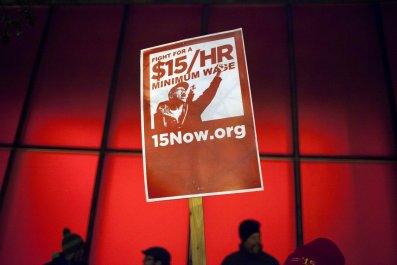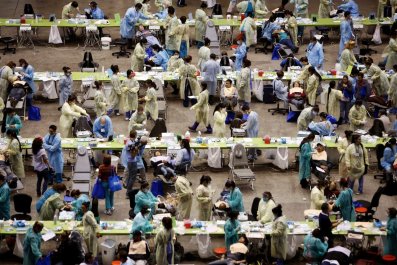A tentative ceasefire between government forces and rebels in the besieged neighborhoods of the Old City of Homs was announced late Thursday afternoon, which just might allow the U.N. teams to evacuate women and children who wish to leave as early as Saturday.
But according to Syrian Opposition sources in Istanbul: "People are wary that the ceasefire actually will happen. There have been so many promises broken already. They also promise that food will be delivered inside by Saturday. But people are starving."
Dima Moussa, a spokeswoman for the Homs Quarters Union, an activist group in the city, says humanitarian aid has not reached the Old City since December 2012.
"It has been over 600 days of siege," she said. "Some limited humanitarian aid got in back then after much negotiation - but nothing since. It has been an absolutely appalling humanitarian situation. People are literally running out of food - they have used up their supplies and now are eating leaves off the trees."
Moussa says seven people have died in the Old City in the past few weeks from starvation, and, "sadly, we expect more."
Starving opponents into submission is not new. But it has only been used as a weapon rarely in recent times.
It is claimed that hundreds of thousands of German civilians died from starvation and disease caused by the Allied trade blockade of Germany, between 1914 and 1919. Hitler famously - and vainly - tried to besiege Leningrad by starving its population; he also starved Jews. Stalin used starvation to kill Ukrainian peasants.
Homs, Syria's third largest city has become a symbol for the suffering of the Syrian people.
While the United Nations's World Food Programme, has been the main provider, distributing food to areas of Homs, "There are parts of Homs - including the Old City - that we are unable to reach," says Abeer Etefa, senior regional public information officer of the programme.
"But if the convoys happen with these new negotiations, we have enough food for 2,500 people. And we have more food in our warehouses, which is only a few miles from the besieged area in Homs."
It is believed that some 3,000 to 5,000 are inside the Old City, though the exact number of civilians, as opposed to fighters, is unclear. The besieged area of Homs was traditionally a mixed Christian and Sunni neighborhood before the war began.
According to Juliette Touma from UNICEF, "What we know is that there are at least 1,100 children trapped in the Old City of Homs."
UNICEF last week submitted a list of urgently needed supplies to the Syrian government, including polio vaccines, winter clothes and tablets for water purification.
The Syrian government has said it is concerned that aid, if it reaches Homs, will fall into the wrong hands - i.e., the rebel fighters'. It lays blame for the starvation on the rebels, who they say are stealing and smuggling aid.
According to Reem Haddad, a spokeswoman for the Ministry of Information in Damascus: "Syria has always been a wheat-producing country, with a stored surplus. Unfortunately, in places where the militants are present the farmers were not allowed to grow or harvest their wheat."
"Wheat was stolen and sold across the border," Haddad said. "Also, in places where the militants are present, they don't allow civilians out, as they need them as human shields. Whenever food is allowed in the militants take it and never give it to the people.
"Whenever rebels are portrayed, they are never skinny - they are even beefy. It is only the civilian population that isn't allowed food by the militants."
It is an accusation, naturally, the rebels deny.
Whatever reason food and other aid has been blocked, life is hard for civilians. There is also daily shelling, no electricity and little communication with anyone outside of Homs - and sometimes not even with people on the next street. Ceasefires offer little reassurance there will be no attacks.
There is a constant sense of isolation and trauma. Early in the war, tunnels were used to smuggle food inside Homs. But, since the heavier fighting began, "The tunnels have shrunk," said one activist. "The area controlled by the rebels gets smaller and smaller."
Even the recent Geneva II talks (held in Geneva and Montreux) were seen by opposition activists as a cynical attempt by diplomats to "say they were doing something concrete about the Syrian suffering, when in fact, on the ground, little is being achieved either to stop the killing or even just to feed people," said one disillusioned Homs resident.
"When I am really hungry," says Rami, who lives inside the Old City, "I go out when there is no shelling. Then I try to find abandoned houses where families who ran away left food supplies stored. I look for old tinned food. I'm a scavenger, but it's all I can do." Hoping to come across a bounty of canned food, all he managed to find was grass which he uses to make soup.
It is late afternoon on Thursday by the time Rami manages to leave his shelter. He says there has been shelling all week and he still has not eaten all day.
"There's just no food. Of course I am hungry, but there is simply nothing to eat. Eating grass is not very satisfying. I have lost five kilos," he said. "Everyone is physically weaker here. We are starving. Starving to death."
For Rami, the clear intention of not allowing convoys to reach Homs is a calculated act. "This is a food war," he said. "It's another way of fighting. It is trying to force the rebels to surrender. How can this be happening? Women and children are not fighters - they are innocent."
"There are not many cats and dogs left in Homs. They have all been eaten," added Rafif Jouejati. who was a delegate for the Syrian Opposition at Geneva II where humanitarian aid to Homs was one of the top issues discussed.
On Thursday, Reuters reported the Russian Foreign Ministry as saying government and rebel fighters had reached an agreement on humanitarian aid to reach Homs.
"The issue of humanitarian access to the Old City of Homs is being discussed," spokesman Alexander Lukashevich told reporters. "Judging by the latest information, it appears that such an agreement between the opposition and the government has already been reached."
On Wednesday, however, Russia opposed a new U.N. Security Council resolution on the humanitarian plight in Syria, which angered opposition leaders and made those stranded inside Homs feel even more desperate.
"I don't understand," said Jouejati. "There are an estimated 10 million people at risk of famine in Syria. We know starvation is being used as a weapon of war. If the Russians - the primary backers of President Assad - say now is not the right time to address this issue, then when is a good time?
"Saying: 'Help is coming soon!' is nothing to people who are starving to death. How many people need to die before you say: It's time for humanitarian assistance?"
"What we know from assessments is that almost half the Syrian population - around 9 million people - are food insecure," said Etefa. This means that they are in need of "food assistance" - official U.N. language for "hungry or at the edge of hunger."
Rami says the most important people to reach first if the food convoys ever arrive are women and children. Milk is sorely lacking, as are fruit and vegetables, even rice.
"Mothers are giving kids olives if they can find them," he said. "People ran out of wheat and flour a long time ago."
But Rami says the most horrific thing is the inability to move in or out of Homs. "No one is getting in, no one is getting out," he said.
Etefa said the WFP food package, if it arrives, will contain flour, oil, sugar, pasta and other foods. But she is unclear what U.N. staff members will find once they are allowed to enter.
"We don't know who is inside and who needs what," she said. "Who knows what's happening inside? This is an area no one has peeked in for many many months."
Even if Homs is relieved, it is just the first of a number of places where ordinary Syrians are being starved into submission.
"It's a good start for the government if they allow the convoys in," said one activist from Homs. "But then they have to think about other areas. Yarmouk [a suburb of Damascus] is also dying of starvation."
According to Jean-Pierre Filiu, a professor of Middle Eastern Studies at Sciences Po, Paris School of International Affairs: "Never have starvation tactics been used in such a systematic and sadistic way in the region."
Filiu says that the "starvation siege" was first imposed in the Damascus area (in Yarmouk) then in the southern suburbs of Daraya and Moadimiya, and later to Eastern Ghouta.
"The objective is nothing less than total surrender of the local insurgents and humiliation of the resisting population," he says. "That is why there was no way a 'humanitarian' ceasefire as envisioned in Geneva could be implemented in Homs."

























